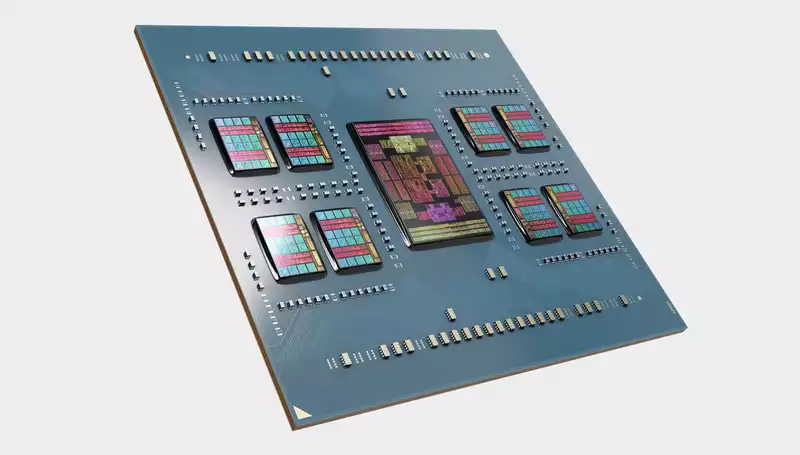Intel has been selling hybrid CPUs with a mix of performance and Efficient cores since it announced its 12th generation Alder Lake CPU in November 2021. As we previously reported, AMD has already improved on Intel's Efficient core in its own way. However, AMD is doing something really different.
We previously explained that AMD's smaller Zen 4c core is functionally identical to the full-fat Zen 4, except that it has half the L3 cache. Nonetheless, it somehow requires only half the space of the Zen 4 core.
In other words, same execution and issue widths, same number of registers, same internal latency, and much more. Yes, this includes multi-threading; would reducing the L3 cache from 4MB per core to 2MB per core make that much of a difference?
Apparently not. To be clear, two Zen 4c cores fit in the space of one Zen 4 core; according to AMD, the Zen 4c core is only 2.48mm2 compared to 3.84mm2 for the Zen 4 core. However, the transition involves more than simply reducing the cache.
YouTube channel TechTechPotato attended a recent AMD Data Center and AI event and managed to uncover some answers. It all comes down to physical design goals. For the full-fat Zen 4, operating frequencies are supported up to 5.5Ghz and beyond. For Zen 4c, however, the clock speed target has been lowered to the low 3 GHz range.
The result is a significant difference in the way the CPU cores are arranged. With lower clocks, the internal structures can be much smaller without having to worry about interference and power leakage associated with higher operating frequencies.
And yet, the cores are functionally identical, offering the same IPC or performance per clock cycle as a full Zen 4, except that the L3 cache difference has a substantial impact. Of course, since gaming is one application that tends to benefit from more cache memory, there are AMD's own X3D CPUs with large amounts of additional cache, such as the Ryzen 7 7800X3D.
In any case, it is a completely different approach than Intel's. The 12th generation Alder Lake and 13th generation Raptor Lake Intel CPUs have two completely different core designs. Intel's Efficient core is even smaller than AMD's, taking up only about a quarter of the space of the Intel Performance core. This means that roughly four Efficient cores can be crammed into the space of one Performance core.
However, there is more asymmetry in Intel's core types, with differences in issue width, latency, and even instruction set. And of course, Intel's Efficient cores do not support multi-threading. This makes managing thread allocation and load balancing a bit more complex in Intel's hybrid design.
Of course, given that the Zen 4c core runs at significantly lower clocks, one should be careful how threads are scheduled. For example, in a desktop gaming PC with a mix of Zen 4 and Zen 4c cores, you want to make sure that all main gaming threads run on the Zen 4 core.
In any case, with this in mind, the next question is when can we expect to see AMD hybrid CPUs in desktops and laptops, and what kind of specs can we expect AMD has announced its first CPU with a Zen 4c core, Bergamo server chip known as Bergamo.
It is a Zen 4c-only design, with up to eight chiplets, each containing 16 Zen 4c cores, for a maximum total of 128 cores and 256 threads. In theory, however, it would be easy enough for AMD to package one of its existing 8-core Zen 4 chiplets or CCDs with a 16-core Zen 4c chiplet, making a 24-core, 48-thread CPU offering for desktops very attractive.
There is no direct evidence that AMD plans to launch such a hybrid Zen 4 chip; AMD has only made a broad commitment to mix "high-performance cores with power efficient cores" in the future. However, it is easy to imagine AMD applying this approach to any future CPU architecture.
For example, if they want to release a hybrid Zen 5 chip, they do not need to design an entirely new core for Zen 5, but can simply apply the same spatial optimizations to Zen 5 as they did to Zen 4 to create Zen 5c. And in fact, according to AMD's public roadmap, just such a "Zen 5c" architecture is planned for next year.
All in all, this seems like a typically clever and efficient approach. Whereas Intel designs entirely new cores and spins billions of different CPU dies, AMD has the ability to tweak existing cores, add one new chiplet design, and mix and match performance and efficiency cores as needed.
Indeed, there are rumors that AMD has done exactly that with its next-generation Zen 5-based laptop APUs, although AMD's laptops are monolithic dies rather than chiplet designs. However, it certainly makes sense to prioritize smaller, more efficient cores for laptops.
It is not yet clear whether we will see hybrid desktop CPUs from AMD in the Zen 5 generation, which will probably be available in late 2024, or possibly not until after Zen 6. However, AMD's hybrid CPUs will appear, and we now have a decent idea of what their hybrid chips will look like and how they will differ from Intel's.
.

Comments